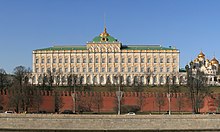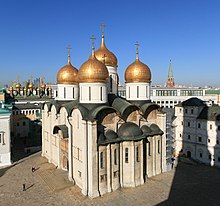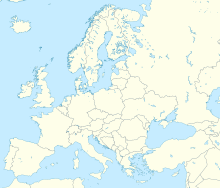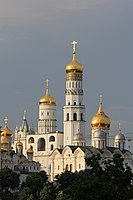Kremlin
| Kremlin | |
|---|---|
| Native name Russian: Московский Кремль | |
 | |
| Location | Moscow, Russia |
| Coordinates | 55°45′6″N 37°37′4″E / 55.75167°N 37.61778°E |
| Area | 27.7 ha (0.277 km2) |
| Built | 1482–1495 |
| Official name | Kremlin and Red Square, Moscow |
| Type | Cultural |
| Criteria | i, ii, iv, vi |
| Designated | 1990 (14th session) |
| Reference no. | 545 |
| Region | Eastern Europe |
The Moscow Kremlin (Russian: Московский Кремль Moskovsky Kreml', IPA: [mɐˈskofskʲɪj ˈkrʲemlʲ]), or simply the Kremlin, is a fortified complex in Moscow, Russia.[1] Located in the centre of the country's capital city, it is the best known of the kremlins (Russian citadels) and includes five palaces, four cathedrals, and the enclosing Kremlin Wall along with the Kremlin towers. Within the complex is the Grand Kremlin Palace, which served as the royal residence of the Russian emperor. It is now the official residence of the President of the Russian Federation. The Kremlin overlooks the Moskva River to the south, Saint Basil's Cathedral and Red Square to the east, and Alexander Garden to the west.
The name kremlin means "fortress inside a city" in Russian,[2] and is often also used metonymically in international politics to refer to the Government of the Russian Federation. Likewise, during the Cold War, it referred to the Government of the Soviet Union, which operated out of the city in the erstwhile Russian SFSR. The term "Kremlinology" is related to the metonym and refers to the study of Soviet and Russian politics.
Largely open to the public, the Kremlin offers supervised tours;[3] the accompanying Moscow Kremlin Museums reportedly attracted approximately three million visitors in 2017.[4]
History
Origin

The site had been continuously inhabited by
Up to the 14th century, the site was known as the "grad of Moscow". The word "Kremlin" was first recorded in 1331[5] (though etymologist Max Vasmer mentions an earlier appearance in 1320[6]). The grad was greatly extended by Prince Yuri Dolgorukiy in 1156, destroyed by the Mongols in 1237 and rebuilt in oak by Ivan I Kalita in 1339.[7]
Seat of the grand dukes
Residence of the tsars
After construction of the new kremlin walls and churches was complete, the monarch decreed that no structures should be built in the immediate vicinity of the citadel. The Kremlin was separated from the walled merchant town (Kitay-gorod) by a 30-meter-wide moat, over which Saint Basil's Cathedral was constructed during the reign of Ivan the Terrible. The same tsar also renovated some of his grandfather's palaces, added a new palace and cathedral for his sons, and endowed the Trinity metochion inside the Kremlin. The metochion was administrated by the Trinity Monastery and contained the graceful tower church of St. Sergius, which was described by foreigners as one of the finest in the country.
During the
| External images | |
|---|---|
The Golden Hall, a throne room with murals painted probably after 1547, was destroyed to make place for the Kremlin Palace, commissioned by Elizabeth of Russia and designed by architect Francesco Bartolomeo Rastrelli in 1752.[8]
Imperial period

Although still used for coronation ceremonies, the Kremlin was abandoned and neglected until 1773, when
During the Imperial period, from the early 18th and until the late 19th century, the Kremlin walls were traditionally painted white, in accordance with fashion.[9]
French forces occupied the Kremlin from 2 September to 11 October 1812, following the French invasion of Russia. When Napoleon retreated from Moscow, he ordered the whole Kremlin to be blown up. The Kremlin Arsenal, several portions of the Kremlin Wall and several wall towers were destroyed by explosions and the Faceted Chamber and other churches were damaged by fire. Explosions continued for three days, from 21 to 23 October 1812. However, rain damaged the fuses, and the damage was less severe than intended. Restoration works were undertaken in 1816–1819, supervised by Osip Bove. During the remainder of the reign of Alexander I, several ancient structures were renovated in a fanciful neo-Gothic style, but many others, including all the buildings of the Trinity metochion, were condemned as "disused" or "dilapidated" and were torn down.

On visiting Moscow for his coronation festivities, Tsar Nicholas I was not satisfied with the Grand Palace (alias Winter Palace), which had been erected in the 1750s to the design of Francesco Rastrelli. The elaborate Baroque structure was demolished, as was the nearby church of St. John the Precursor, built by Aloisio the New in 1508 in place of the first church constructed in Moscow. The architect Konstantin Thon was commissioned to replace them with the Grand Kremlin Palace, which was to rival the Winter Palace in St. Petersburg in its dimensions and in the opulence of its interiors. The palace was constructed in 1839–1849, followed by the re-building of the Kremlin Armoury in 1851.
After 1851 the Kremlin changed little until the

Soviet period
The Soviet government moved from Petrograd (present-day Saint Petersburg) to Moscow on 12 March 1918. Vladimir Lenin selected the Kremlin Senate as his residence. Joseph Stalin also had his personal rooms in the Kremlin. He was eager to remove all the "relics of the tsarist regime" from his headquarters. Golden eagles on the towers were replaced by shining Kremlin stars, while the wall near Lenin's Mausoleum was turned into the Kremlin Wall Necropolis.
The
During the

The residence of the Soviet government was closed to tourists until 1955. It was not until the
Although the current director of the Kremlin Museums, Elena Gagarina (Yuri Gagarin's daughter), advocates a full-scale restoration of the destroyed cloisters, recent developments have been confined to expensive restoration of the original interiors of the Grand Kremlin Palace, which were altered during Stalin's rule.
Overall, during the Soviet rule (1917–1991), 28 out of 54 historic buildings in the Kremlin were destroyed (among them 17 out of 31 churches and cathedrals), most of them centuries-old.[11]
State Kremlin Palace

The
Buildings


The existing
Originally there were eighteen
There are two domestic churches of the Metropolitans and Patriarchs of Moscow, the Church of the Twelve Apostles (1653–1656) and the exquisite one-domed Church of the Deposition of the Virgin's Robe, built by Pskov artisans from 1484 to 1488 and featuring superb icons and frescoes from 1627 and 1644.
The other notable structure is the
The oldest secular structure still standing is Ivan III's Palace of Facets (1491), which holds the imperial thrones. The next oldest is the first home of the royal family, the Terem Palace. The original Terem Palace was also commissioned by Ivan III, but most of the existing palace was built in the 17th century. The Terem Palace and the Palace of Facets are linked by the Grand Kremlin Palace. This was commissioned by Nicholas I in 1838. The largest structure in the Kremlin, it cost 11 million rubles to build and more than one billion dollars to renovate in the 1990s. It contains dazzling reception halls, a ceremonial red staircase, private apartments of the tsars, and the lower story of the Resurrection of Lazarus church (1393), which is the oldest extant structure in the Kremlin and the whole of Moscow.
The northern corner of the Kremlin is occupied by
The haloalkaliphilic methylotrophic bacterium Methylophaga muralis (first called Methylophaga murata) was first isolated from deteriorating marble in the Kremlin.[12]
Helipad

To stop disruptions to traffic caused by motorcades, Russian President Vladimir Putin authorized the construction of a helipad in the Kremlin. The helipad was completed in May 2013. The Russian President will now commute back and forth to the Kremlin using a Mil Mi-8 helicopter. Careful consideration was taken in choosing the location of the helipad. The location chosen is said to be of no threat to the architecture of the Kremlin.[13]
Stations of the Moscow Metro
The nearest
References
Citations
- . S2CID 159954818.
- ^ "Кремль" [Kremlin]. Vasmer Etymological dictionary. Archived from the original on 4 December 2022. Retrieved 2 June 2014.
- ^ "Moscow Kremlin Museums: VISIT US". kreml.ru. Archived from the original on 24 October 2022. Retrieved 14 October 2020.
- ^ "Moscow Kremlin Museums: ABOUT THE MUSEUM". Archived from the original on 30 October 2022. Retrieved 4 October 2020.
- ISBN 9789350878453. Retrieved 13 August 2015.
- ^ Фасмера, Макс. "Этимологический Словарь Фасмера" [Vasmer's Etymological Dictionary] (in Russian). p. 321. Archived from the original on 27 October 2017. Retrieved 12 October 2012.
- ^ S2CID 159954818.
- OCLC 1145926960.
- ^ Semenko, Xenia (25 November 2013). "Почему кремлевские стены красили в белый цвет" [Why the Kremlin walls painted white]. Rossiyskaya Gazeta (in Russian). Archived from the original on 18 May 2017. Retrieved 18 May 2017.
- ^ MANAEV, GEORGY (9 May 2019). "How the Russians made the Kremlin 'disappear' during". Russia Beyond. Archived from the original on 16 January 2022. Retrieved 16 January 2022.
- ^ "Константин Михайлов: Уничтоженный Кремль". Archived from the original on 21 August 2023. Retrieved 8 February 2023.
- PMID 16211855.
- ^ Rosenberg, Steve (27 May 2013). "Vladimir Putin gets Kremlin helipad to ease congestion" (Embedded video). BBC News. Archived from the original on 13 March 2017. Retrieved 18 May 2017.
Bibliography
- Ivanov, Vladimir N. (1971). Московский Кремль [Moscow's Kremlin] (in Russian). Moscow.
{{cite book}}: CS1 maint: location missing publisher (link) - ISBN 9780805086805.
- Nenakormova, Irina S. (1987). Государственные музеи Московского Кремля [Art treasures from the Museums of the Moscow Kremlin] (in Russian). Moscow: Iskusstvo.
External links
- tour-planet.com – Sights of the Moscow Kremlin
- Kremlin.ru - Map of the Kremlin
- Travel2moscow.com – Official Moscow Guide
- History of the Kremlin
- Moscow Kremlin State Historical and Cultural Museum Sanctuary
- Open Kremlin
- Rare access inside the Kremlin, video news report from BBC News Online, 17 January 2013
- Cynthia Marsh. "Kremlin". Words of the World. Brady Haran (University of Nottingham).







